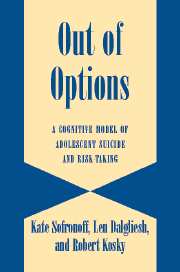Book contents
- Frontmatter
- Contents
- Preface
- Introduction
- 1 Adolescent Suicide: An Overview of the Epidemiology
- 2 Risk and Predisposing Factors in Adolescent Suicide
- 3 Emotional Problems and Adolescent Suicide
- 4 Adolescent Suicide: Cognitive Variables
- ADOLESCENT RISK-TAKING
- A MODEL OF SUICIDE AND RISK-TAKING
- AN EVALUATION OF THE S/RT MODEL
- IMPLICATIONS FOR TREATMENT
- References
- Index
Introduction
Published online by Cambridge University Press: 03 September 2009
- Frontmatter
- Contents
- Preface
- Introduction
- 1 Adolescent Suicide: An Overview of the Epidemiology
- 2 Risk and Predisposing Factors in Adolescent Suicide
- 3 Emotional Problems and Adolescent Suicide
- 4 Adolescent Suicide: Cognitive Variables
- ADOLESCENT RISK-TAKING
- A MODEL OF SUICIDE AND RISK-TAKING
- AN EVALUATION OF THE S/RT MODEL
- IMPLICATIONS FOR TREATMENT
- References
- Index
Summary
There are many different definitions of suicide, and it is important for us to define from the outset what we mean by suicide and attempted suicide. Durkheim (1951), in his important contribution to the taxonomy of suicide, “Le Suicide,” defined suicide as follows:
All cases of death resulting directly or indirectly from a positive or negative act of the victim himself which he knows will produce this result, whereas an attempt is an act thus defined but falling short of the actual death.(p. 44)
It is this definition that we use in this book. In particular, we should note that when we talk about “attempted” suicide, we are talking about failed suicide. In other words, the young people in this book who make up the categories involving attempted suicide were drawn from hospital populations. Their suicidal act had resulted in damage to themselves to the extent that they required medical treatment, even though this damage fell short of actual death. Since it is not possible to use young people who have completed suicide in research of this type, those who have failed in the suicide attempt are the closest we can come to a group who have not survived the tragedy of suicide.
The definition proposed by Durkheim has proved useful for purposes of communication among workers in the field and for gathering statistics. It forms the basis of the national statistics available from most countries. However, it has its limitations.
- Type
- Chapter
- Information
- Out of OptionsA Cognitive Model of Adolescent Suicide and Risk-Taking, pp. 1 - 10Publisher: Cambridge University PressPrint publication year: 2004



